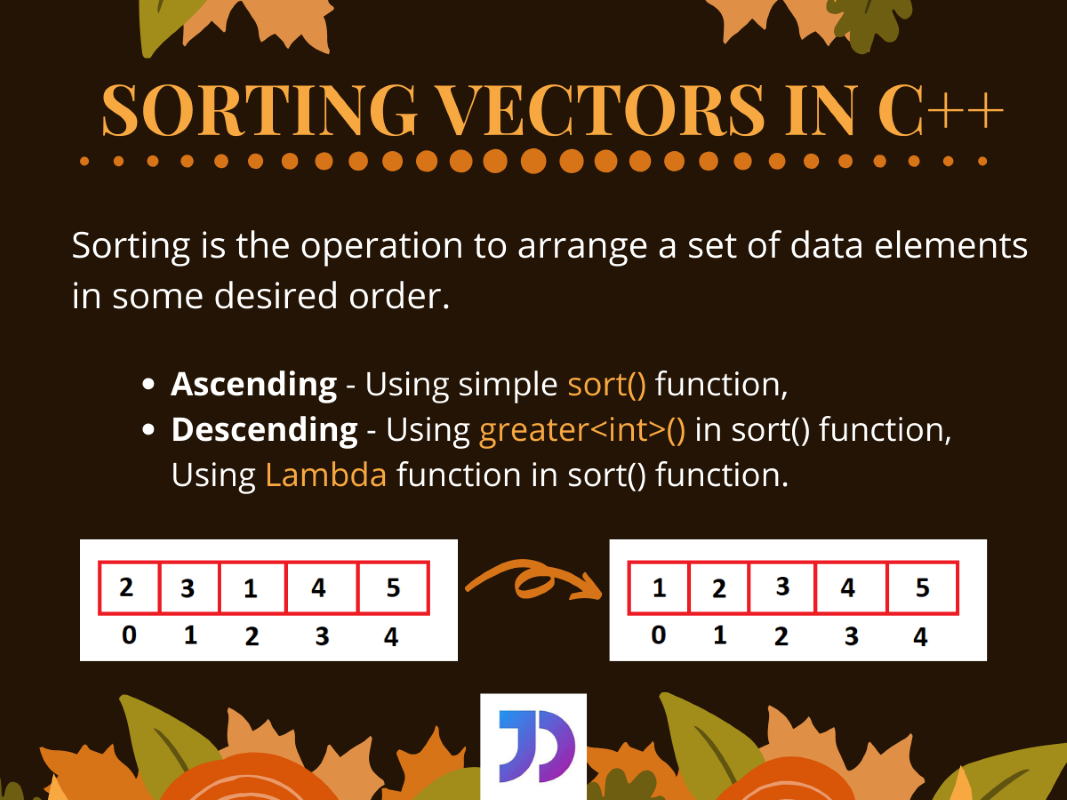- Log in to:
- Community
- DigitalOcean
- Sign up for:
- Community
- DigitalOcean

Introduction
In this tutorial, we are going to focus on Sorting a Vector in C++.
Sorting is one of the vastly performed operations in any programming language. Similarly, in C++ too, there are several algorithms following which we can sort any data structure.
For vectors, in particular, we can perform sorting operations in any order(ascending or descending).
Sorting a Vector in C++ in Ascending order
A vector in C++ can be easily sorted in ascending order using the sort() function defined in the algorithm header file.
The sort() function sorts a given data structure and does not return anything. The sorting takes place between the two passed iterators or positions. The third parameter determines the order in which the elements are going to be compared.
By default, for not passing the third parameter, the function considers it to be the std::less<int>() function. This function returns true or false on the basis of comparing two arguments, whether the first one is less than the other.
So, now let us see how we can sort a vector in C++(ascending order).
#include<iostream>
#include<vector>
#include<algorithm>
using namespace std;
int main()
{
//vector initialisation
vector<int> vec {5, 4, 3, 2, 1};
cout<<"Before sorting vector : ";
for(auto i=vec.begin(); i<vec.end(); i++)
{
cout<<" "<<*i;
}
std::sort(vec.begin(),vec.end());//Sorting the vector
cout<<"\n\nAfter sorting vector : ";
for(auto i=vec.begin(); i<vec.end(); i++)
{
cout<<" "<<*i;
}
return 0;
}
Output:
Before sorting vector : 5 4 3 2 1
After sorting vector : 1 2 3 4 5
Sorting a Vector in C++ in Descending Order
As we said earlier, the third argument for the sort() function in C++ determines the order of sorting. So, we can define functions in it to sort any vector in our desired order(descending in this case).
1. Using greater<int>() in sort()
Similar to the less<int>() function, the greater<int>() function returns a bool value as true or false but in the opposite sense. If the first argument is greater than the second one, the function returns true and false if the above condition is false.
Let us see how we can use it to get a sorted vector in descending order.
#include<iostream>
#include<vector>
#include<algorithm>
using namespace std;
int main()
{
//vector initialisation
vector<int> vec { 2,4,6,8,10 };
cout<<"Before sorting vector : ";
for(auto i=vec.begin(); i<vec.end(); i++)
{
cout<<" "<<*i;
}
std::sort(vec.begin(),vec.end(), greater<int>());//Sorting the vector using greater<int>() function
cout<<"\n\nAfter sorting vector : ";
for(auto i=vec.begin(); i<vec.end(); i++)
{
cout<<" "<<*i;
}
return 0;
}
Output:
Before sorting vector : 2 4 6 8 10
After sorting vector : 10 8 6 4 2
2. Using Lambda Expression in sort()
Since C++11, the use of lambda expressions was introduced to C++ programming. They are nothing but simple one-line functions, which do not need declaration or even require to specify their return type.
Hence, we can use our own defined lambda expression to determine the order of sorting by the sort() function. This can be done by defining the one-line expression as the third parameter to the sort() function. Let see how
#include<iostream>
#include<vector>
#include<algorithm>
using namespace std;
int main()
{
//vector initialisation
vector<int> vec { 11,22,33,44,55 };
cout<<"Before sorting vector : ";
for(auto i=vec.begin(); i<vec.end(); i++)
{
cout<<" "<<*i;
}
std::sort(vec.begin(),vec.end(), [](int &a, int &b){ return a>b; });
//Sorting the vector using user-defined lambda expression(return type bool)
cout<<"\n\nAfter sorting vector : ";
for(auto i=vec.begin(); i<vec.end(); i++)
{
cout<<" "<<*i;
}
return 0;
}
Output:
Before sorting vector : 11 22 33 44 55
After sorting vector : 55 44 33 22 11
Here, the expression a>b is used to compare two passed arguments from the vector. As we can see from the output for the above code, the vector gets sorted in descending order as desired.
Conclusion
So, in this article, we learned about sorting a vectors in C++, in both ascending and descending order. For any further questions related to this topic, feel free to use the comments below.
References
- Sorting in STL - JournalDev Tutorial,
- <algorithm> - C++ algorithm Library,
- How to sort an STL vector? - StackOverflow Question,
- Sorting a vector in descending order - StackOverflow Question.
Thanks for learning with the DigitalOcean Community. Check out our offerings for compute, storage, networking, and managed databases.
Still looking for an answer?
- Table of contents
- Introduction
- Sorting a Vector in C++ in Ascending order
- Sorting a Vector in C++ in Descending Order
- Conclusion
- References
Deploy on DigitalOcean
Click below to sign up for DigitalOcean's virtual machines, Databases, and AIML products.
Become a contributor for community
Get paid to write technical tutorials and select a tech-focused charity to receive a matching donation.
DigitalOcean Documentation
Full documentation for every DigitalOcean product.
Resources for startups and SMBs
The Wave has everything you need to know about building a business, from raising funding to marketing your product.
Get our newsletter
Stay up to date by signing up for DigitalOcean’s Infrastructure as a Newsletter.
New accounts only. By submitting your email you agree to our Privacy Policy
The developer cloud
Scale up as you grow — whether you're running one virtual machine or ten thousand.
Get started for free
Sign up and get $200 in credit for your first 60 days with DigitalOcean.*
*This promotional offer applies to new accounts only.
